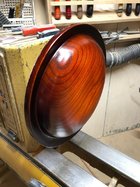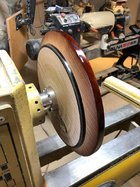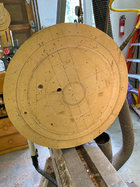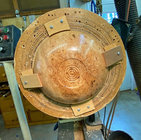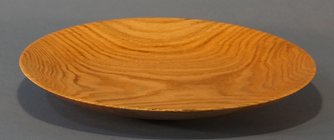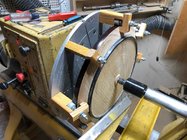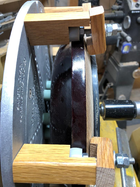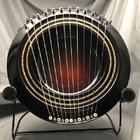I’m working on a fairly complex project. For descriptive purposes we can call it a shallow bowl, almost platter like. I’ve got the outside nearly finished. It has many coats of nitrocellulose lacquer. There is no foot on the “bowl”. My intention for reverse chucking it, was to hot glue a block with a tenon onto the bottom. Now that it is about time to do that, I’m having second thoughts. I’m concerned that the hot glue will damage the lacquer. I would expect minor damage that I could repair. But I started wondering if it could cause the lacquer to blister or blush. Plus, I’d have to get the block and glue off in the end, probably involving heat. A risky endeavor. Then of course there is the chance that the hot glue wouldn’t hold adequately and the whole thing would come flying off the lathe. The inside turning is going to be a little complicated, with some undercuts, awkward angles, and a consistent 1/8” thickness.
So, I started thinking about other options. I considered some sort of donut chuck attached to my Cole Jaws. But that would obstruct my ability to see the sides and bottom which would be necessary to get uniform thickness.
Next, I started considering my vacuum chuck. That may be the best option, but I think there are going to be some difficulties. First, I haven't used the vacuum chuck much and am not sure how much I trust it. The data says it should hold, but intuitively it seems sketchy to me. Second, I’m a slow turner. I have some health problems that limit my stamina. Oftentimes I can work for 15 minutes, then have to go rest for an hour. What takes many of you guys a couple of hours to turn can take me a couple of weeks. I’m okay with that, it’s not a race. But I can’t keep the vacuum running all that time. Obviously, I can pin things to the chuck with the tail stock while not using it, but I’m just wondering if anyone has any great ideas for keeping things registered on a vacuum chuck when not in use. I’ll leave a little point in the bottom for the live-center to register on. I was also thinking about outlining the outside of the bowl around the chuck with masking tape. I may just rough turn the inside of the bowl until the end, so a little bit of error may not matter. I can tune it up at the end.
So, do any of you folks have any other suggestions for keeping things registered on a vacuum chuck over a couple of weeks?
So, I started thinking about other options. I considered some sort of donut chuck attached to my Cole Jaws. But that would obstruct my ability to see the sides and bottom which would be necessary to get uniform thickness.
Next, I started considering my vacuum chuck. That may be the best option, but I think there are going to be some difficulties. First, I haven't used the vacuum chuck much and am not sure how much I trust it. The data says it should hold, but intuitively it seems sketchy to me. Second, I’m a slow turner. I have some health problems that limit my stamina. Oftentimes I can work for 15 minutes, then have to go rest for an hour. What takes many of you guys a couple of hours to turn can take me a couple of weeks. I’m okay with that, it’s not a race. But I can’t keep the vacuum running all that time. Obviously, I can pin things to the chuck with the tail stock while not using it, but I’m just wondering if anyone has any great ideas for keeping things registered on a vacuum chuck when not in use. I’ll leave a little point in the bottom for the live-center to register on. I was also thinking about outlining the outside of the bowl around the chuck with masking tape. I may just rough turn the inside of the bowl until the end, so a little bit of error may not matter. I can tune it up at the end.
So, do any of you folks have any other suggestions for keeping things registered on a vacuum chuck over a couple of weeks?

